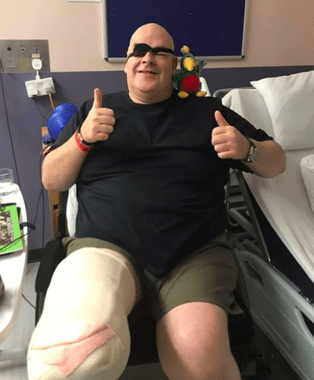
Diabetic Man, 50, Shares Story to Help Others from Losing Limbs
In Greater Nashville, Podiatrists are seeing the results from the latest epidemic to hit United States over recent years. The Centers for Disease Control states that over 30 million people have diabetes and 1 in 4 don’t even know it.
24% of diabetics that develop a foot ulcer have an amputation, according to the American Podiatric Medical Association.
This is all too true for Colin Rattray, 50. Mr. Rattray is sharing his story in hopes it would help others with diabetes make better choices about their health.
After ignoring their advice for years, doctors amputated his entire lower leg last month.
“How does someone lose a foot because of diabetes?”
Rarely is it the entire foot at once. In Mr. Rattray’s case, and in most cases that our podiatrists in Nashville and across Middle Tennessee see, it starts with losing a toe often related to diabetic peripheral neuropathy.
Penninah Kumar, DPM, Neuhaus Foot & Ankle podiatrist in Mt. Juliet, specializes in foot problems related to diabetes. She says not checking your feet frequently is a critical mistake.
“High blood sugar causes the nerves of your feet to deaden, reducing the feeling in your feet and toes. A small cut can turn into a more serious wound.”
Cuts and wounds don’t heal the same way those without diabetes heal. A diabetic foot often has decreased blood flow, significantly slowing the healing process. In severe cases, these open wounds don’t heal and they actually worsen.
The First Amputation
Several years ago, Mr. Rattray stubbed his toe at work.
The next morning, he noticed the skin on his toes turning dark.
Over the next couple of weeks it darker and started to turn black. This scared him so much that he went to the ER.
An ER nurse looked at his black toe and asked him if he was diabetic.
“I told her I was and she looked at me and said: ‘Well, that will be coming off then.’
“I thought she was having a laugh.”
Mr. Rattray was rushed into surgery and after a three hour operation, he was left with three toes on his foot.
Doctors told him he needed to control his diabetes and eat better. But Mr. Rattray was just relieved that he didn’t lose his whole leg. Instead, he continued his daily diet of junk food and sugary drinks. Cakes, biscuits, chocolate bars, pastries, and soda whenever he wanted.
Losing His Leg, Learning a Lesson
Then, late last year, Mr. Rattray realized he had a “huge” infected ulcer on his right foot. This time, he knew what might be coming.
There was so much damage to his bone caused by the infected and untreated wound, there was little choice but to remove his lower leg and foot.
It’s hard to believe this happens, but it does. With uncontrolled diabetes, you can lose feeling in your feet and wounds can turn for the worst before you even notice them. You may never even feel the pain.
This can happen with uncontrolled diabetes. After several warnings from doctors, Mr. Rattray continued to eat as he pleased.
‘Doctors told me to stop eating sausage rolls and biscuits but I didn’t…now I’ve lost my leg’
Not a month goes by that our podiatrists in Nashville and across Middle Tennessee aren’t removing a foot or toe. These can all be prevented with proper footwear and foot care.

Mr. Rattray is now recovering from the amputation and learning to walk again. Though, he recalls watching the saw remove his own leg and feeling its vibrations. That’s when his poor health really hit home. He vowed to make a change and turn his bad habits around.
‘He recalls watching the saw remove his own leg and feeling its vibrations.’
Learning to walk again after amputation. Source: Colin Rattray, Facebook
A ‘glass half-full type of guy,’ he is learning to walk with his prosthetic leg and looks forward to getting out of the hospital. As you can imagine, Mr. Rattray is encouraging those with type 2 diabetes to eat healthiy and to make proper foot care a priority.
Nashville Podiatrist Notes
Make a habit of looking at your feet daily. Look at the top, sides, bottom, and between the toes for changes in color or breaks in the skin.
Treat your feet by wearing shoes in and out of the house. If you cannot cut your nails, or if you have calluses, corns, ingrown nails, or toenail fungus, consider making an appointment with a podiatrist.
Read frequently asked questions about diabetic foot and more advice on preventing wounds and amputation here.
Read more about Mr. Rattray’s story.
You Might Also Enjoy…
Contact us:
Whatsapp: +86 13606916530
Email: [email protected]
Hot blogs:
The Easiest Custom Insoles: Heat Moldable Insoles
Custom insoles, also known as orthotic insoles, are designed to provide personalized support and comfort for individuals with various foot conditions. In [...]
Children’s Insole Size Conversion Chart
The standard sizes for shoe insoles may vary from country to country, making it a headache to choose the right insole for [...]
Do custom orthotics need to be made by a doctor personally?
Custom orthotics do not necessarily need to be made by a doctor personally. While doctors, specifically podiatrists or orthopedic specialists, are often [...]
Do NBA players use custom insoles?
Custom insoles are not only helpful for people with foot health issues, but they also play a significant role in targeting the [...]
